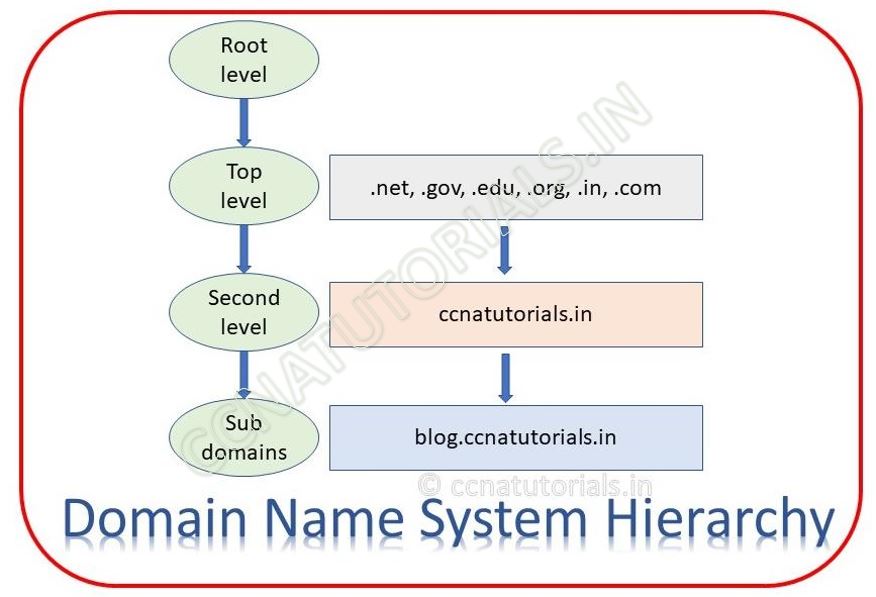In this article I describe the DNS Domain Name System Protocol in computer network for CCNA exam. DNS Domain Name System Protocol is related to application layer of TCP/IP Suite model. The DNS Domain Name System protocol resolve the IP address against the domain name in the network. DNS Domain Name System Protocol forward the IP packets with the domain name related to that IP address in the network. The DNS Domain Name System Protocol is reliable so if any new device do not know the IP address of a domain, it will automatically redirect the traffic to IP address relates to the domain name. A standard DNS table is maintained by the DNS servers for all connected devices in the network.
Before going to learn about DNS Domain Name System Protocol we need to remember the OSI suite and TCP/IP suite model. There are many manufacturer of computer machine in the market. Initially when computers became single user public computer. The computers communicate with only same brand machines. It happens because there was no any fix standard for data transfer between different devices. It is very difficult to make communication with each other when the hardware are of different brands or company. In this article I describe the some basic part of OSI reference layer and TCP/IP Suite model basic concepts in networking with DNS Domain Name System Protocol.
OSI reference model in computer network followed by various vendors to overcome the compatibility problem. After implementation of OSI reference model in computer network, equality maintains by all manufacturer. In 1970 the Open Systems Interconnection (OSI) reference model was created by the International Organization for Standardization (ISO). The OSI model was meant to create inter-operable network with different manufactured devices. In this article I describe some layered approach of TCP/IP Suite model basic concepts in computer network. Before understanding the TCP/IP Suite model basic concepts it is necessary to know about the 7 layers of OSI reference model because the basic work of each layer is described in the OSI reference model. You can read the full article related to OSI reference model in computer networking here.
Importance of OSI reference model
Before going to know about the DNS Domain Name System Protocol. It is necessary to know the function of application layer in OSI model and TCP/IP model. Initially not only hardware but software also not supported for work the different computer brand. It became very difficult for all computer users to working without implementation of OSI reference model in computer network. It is necessary then to make some common protocols for all vendors of computer. Before implementation of OSI reference model in computer network, all vendors implements their own protocols on computer hardware and software.
In networking OSI reference model became helpful. OSI reference model describes the flow of data between nodes in any network. Data from one computer application to another computer application transfer by following some common protocols. The OSI reference layer also become beneficial for troubleshooting the network problems. TCP/IP and Cisco three layered hierarchical model of Cisco became more helpful alongside the OSI reference model.
The Layered Approach in computer network for DNS Domain Name System Protocol.
The Layered approach was the best way to make equality for all computer devices. Layers are not physical but following some protocols. Protocols are for connectivity, connections, data transfer and more. All manufacturer begin to follow the layered approach for OSI reference model in computer network. The OSI reference model change in TCP/IP reference model and later on Cisco three layered hierarchical model. OSI layer architecture have 7 layers. TCP/IP reference model convert these 7 layers into only four layers. After that Cisco three layered hierarchical model converts these 7 layers into three layers. Some layers combined to work in a single layer.
OSI is acronym for open system interconnection. The OSI is a logical reference OSI reference model in computer network. OSI model helps for data flow between different devices and operating systems. All manufacturer used their own architecture before invention of OSI reference model. It was very difficult to establish data communication between different devices. To overcome this problem international organization for standardization (ISO) created the open systems interconnection (OSI) reference model. OSI reference model make data flow possible between different operating system, devices and hardware. Later the OSI model adopted by Cisco as Cisco three layered hierarchical model.
Structure of OSI reference model
OSI reference model in computer network consist of 7 layers. These 7 layers further divided into two groups. First 3 layers works for application communication and remaining 4 layers works for data flow. Application, presentation and session layers define the application communication. Transport, network, data link and physical layers define the data flow. Networking protocols works only on last four layers.
TCP/IP Suite model basic concepts
TCP/IP is acronym for Transmission Control Protocol/Internet Protocol (TCP/IP suite model). In this section of the article I describe about TCP/IP suite model basic concepts in detail. TCP/IP suite model is a reference model like OSI layers. Instead of 7 layers of OSI reference model. TCP/IP suite model consist only four layer. All seven layers are merged into four layers only. TCP/IP suite model was designed and implemented by Department of Defence (DoD). TCP/IP developed to preserve data integrity. The main purpose to develop the TCP/IP is to provide security in the network. A lots of protocols works on each layer to provide a secure network.
It is necessary to understood the protocols used in TCP/IP Suite model basic concepts. IP addressing play an important role in TCP/IP Suite model basic concepts. By using the IP address and subnet masking broadcast domain breaks. It will improve the performance of the network. Breaking broadcast domain increase the data flow speed. Here IP stands for IPV4 only. We ignore the IPV6 for some time in this article. It will make it easy to understand the TCP/IP Suite model basic concepts.
A snap of TCP/IP Suite model basic concepts
In the decade of 1970’s TCP/IP suite model developed by DoD. In the initial stage TCP/IP suite model divided into two segments TCP and IP. Later its name registered with combined name of TCP and IP like TCP/IP model. ARPA, the Advanced Research Projects Agency of DoD officially authorised to use TCP/IP suite model. TCP/IP model was working well so it was adopted by many organisations. In today scenario it is mostly using reference model for networking. Internet is the best example of using TCP/IP.
Basic Idea of Layers of TCP/IP Suite model
There are four layers in DoD model. As shown in above image. Top 3 layers of OSI combined and create the Process/Application layer. Transport layer remain Transport layer. Network layer become internet layer and last two layer combined and called link layer. You can see both model are similar in concept.

Process or Application layer of DoD model in TCP/IP Suite model

This is the first layer of TCP/IP of DoD model. It is combination of top three layers of OSI reference model. The functions of Application layer, presentation layer and session layer in OSI model works in single layer process layer. This layer supports the point to point communication and controls the user interface. The data encryption and decryption also done at this layer. Example of some protocols functions at this layer are Telnet, FTP, LPD, TFTP, SMTP.
Transport layer of DoD model in TCP/IP Suite model

Transport layer of TCP/IP is same as the Transport layer of OSI reference model. It supports the TCP and UDP protocol. This protocol converts the main data segment into packets and transport to the internet layer. The responsibility of Transport layer is to combine the segments and built the data. The data should be reconstruct in its real form. Transport layer is also responsible for creating end-to-end communication between sender and receiver. This layer ensure the delivery of segment in sequence at the receiving device. This property maintains the data integrity.
Internet layer of DoD model in TCP/IP Suite model

Internet layer of TCP/IP is similar to the network layer of OSI reference model. Routing protocols functions on Internet layer of TCP/IP model. Addressing and filtering of packets is main responsibility of Internet layer of TCP/IP model. This layer provides the transmission of packet in the whole network. Some example of protocols functions on internet layer are ICMP, ARP and IP.
Link layer of DoD model in TCP/IP Suite model

Link layer is the least layer of TCP/IP. Basically link layer is combination of data link and physical layer of OSI reference model. Link layer is also known as Network Access layer. It works on MAC address based data transmission. Link layer handles the frame and bits. It receive the bits and constructs frame from merging bits in a sequence. In case of any bit is missing this layer request to re transmit the bits. Ethernet, FDDI, WAP etc functions on this layer. There is no any preset specification for link layer. Link layer functions on any type of existing media.
DNS Domain Name System explained
The DNS Domain Name System is a hierarchical decentralised naming system for Internet services or private network. DNS Domain Name System is a distributed naming system which is organised in a hierarchy. DNS is a protocol that can be used in different platform on the internet. In any network each device communicates with its IP address. On internet a user doesn’t need to type the IP address of any website. DNS Domain Name System resolve the IP address of a website and route the traffic to the related web server. Each packet has its source and destination IP address. The packets move to correct destination by routing. No any packet has information about the website name for which the packet is moving.
DNS Domain Name System is a service which is responsible for translates domain names into IP addresses. Multiple DNS server are used on internet to resolve the website and IP addresses.
Name space in DNS Domain Name System
The names of domain must be selected from a perfect name space. So that the binding of names can be done with IP addresses smoothly. Name Space are of two types, Flat name and Hierarchical name.
Flat name space is a combination of characters without structure. Flat name space is convenient and short. A Flat name space can be used in private network. Such names cannot be used in internet.

Hierarchical Name Space is a combination of multiple parts. These parts may be denoting the name of organisation, department of organisation etc. different organisation maintains their own hierarchical name space. These names registered in DNS server against IP address. DNS server provides the name and IP resolving services for internet.
DNS Domain Name System in the Internet
The DNS Domain Name System have many sections in internet. The best example of one section is country domain. On internet you can see the root domain is short name of country like .uk for United Kingdom and .in for India .au for Australia etc.
DNS Domain Name System definition
DNS Domain Name System is the most necessary protocol of internet. The DNS service converts the domain name into IP address. So that the computers can communicate with each other on the network. DNS is mostly used on internet and other private networks like intranet.
Working of DNS Domain Name System
DNS works like a phone directory. How many phone numbers can a human remembered? With the help of phone directory, a human can use thousands of phone number without remembering them. DNS works like phone directory for IP address and domain names. The difference is DNS address book is restored in DNS server which is not reachable to a user. DNS protocol resolve the IP address or a domain name.

Let the website ccnatutorials.in is hosted on web server whose IP address is xx.xx.xx.xx. A user wants to access the website ccnatutorials.in. The user simply types the web address in its browser address bar. The web server is not in the LAN of user, so the packets goes out from the gateway. Now the first server required is DNS server because no any router on internet know any website address. To reach up to the web server it is require resolving the IP address of domain name. DNS server resolve the address of ccnatutorials.in to IP address xx.xx.xx.xx. After getting the address user’s communication established with web server of IP address xx.xx.xx.xx. Now the user can see the website ccnatutorials.in.
There are millions of websites on the internet and it is not easy to remember their IP address. DNS makes it easy to access the internet without remembering the IP address of websites. That’s why DNS and alternate DNS address are configured in IP address section.
Forward and Reverse look up in DNS Domain Name System.

In above example a user want to access ccnatutorials.in from his computer. The user simply type the URL of website. Firstly a DNS request sent to DNS server to know the IP address of ccnatutorials.in. DNS resolve the IP address against ccnatutorials.in and provide to the router. This service is known as Forward look up.

Just opposite of Forward Look up. DNS resolve the domain name of an IP address and provide domain name.
DNS Domain Name System Cache memory
Every time when a user access any website on internet. The domain name and its IP address restored in browser like cookies. Next time when any user search for same website on same computer, the communication automatically established with the web server without DNS service.
Primary and Secondary DNS server
Primary DNS server provides editing of data. Administrator can add new DNS entry or delete the old one from primary DNS servers. All changes of DNS data done in primary DNS server
Secondary DNS servers are true replica of primary DNS server. The difference is secondary DNS servers data is read only data. Data updation done via the primary DNS server. Every time when primary DNS server data changes then secondary DNS server update its data from primary DNS server.
In this article I describe the DHCP Dynamic Host Configuration Protocol in local area network for CCNA Exam. I hope you found this article helpful. For any query or suggestion you may drop a comment below or contact us. Your suggestions are always welcome by us.







Hi to all, it’s truly a fastidious for me to pay a visit this web page, it
consists of important Information.
Wonderful post however I was wondering if you could write a litte more on this
topic? I’d be very grateful if you could elaborate a little bit more.
Bless you!
Its such as you read my thoughts! You appear to grasp a lot about this, like you wrote the ebook in it or something.
I feel that you simply can do with a few % to power the message house
a little bit, however instead of that, that is excellent blog.
An excellent read. I’ll certainly be back.
This is really interesting, You’re a very skilled blogger.
I have joined your rss feed and look forward to seeking more of your excellent post.
Also, I’ve shared your website in my social networks!
Hey there would you mind letting me know which hosting company you’re working with?
I’ve loaded your blog in 3 completely different internet browsers and I must
say this blog loads a lot quicker then most. Can you suggest a good hosting provider at a reasonable price?
Thanks a lot, I appreciate it!
Hi there! Do you know if they make any plugins to protect against
hackers? I’m kinda paranoid about losing everything I’ve
worked hard on. Any tips?
Hi just wanted to give you a quick heads up and let you
know a few of the images aren’t loading correctly.
I’m not sure why but I think its a linking issue. I’ve tried it in two different internet browsers and
both show the same results.
This site was… how do you say it? Relevant!!
Finally I’ve found something which helped me. Appreciate it!
Hi, I do believe this is an excellent blog. I stumbledupon it 😉
I may come back yet again since i have saved as a favorite it.
Money and freedom is the best way to change, may you be rich and continue to
guide other people.
What’s up everyone, it’s my first visit at this web page, and article is truly fruitful in support of me,
keep up posting such content.
Every weekend i used to go to see this website, as i want enjoyment, for the
reason that this this web site conations genuinely pleasant funny data too.
As the admin of this site is working, no doubt very rapidly it will be famous,
due to its feature contents.
Thank you for the good writeup. It in fact was a amusement account it.
Look advanced to more added agreeable from you! However, how can we communicate?
When someone writes an piece of writing he/she keeps the idea of a user in his/her brain that how
a user can understand it. Therefore that’s why this paragraph is perfect.
Thanks!
It’s amazing in favor of me to have a site, which is valuable for my
experience. thanks admin
Hello this is kinda of off topic but I was wondering if blogs use WYSIWYG editors or if you have to manually code with HTML. I’m starting a blog soon but have no coding know-how so I wanted to get advice from someone with experience. Any help would be greatly appreciated!|
I like the valuable information you provide on your articles. I’ll bookmark your weblog and test again right here regularly. I am reasonably certain I will be informed lots of new stuff right right here! Best of luck for the next!|